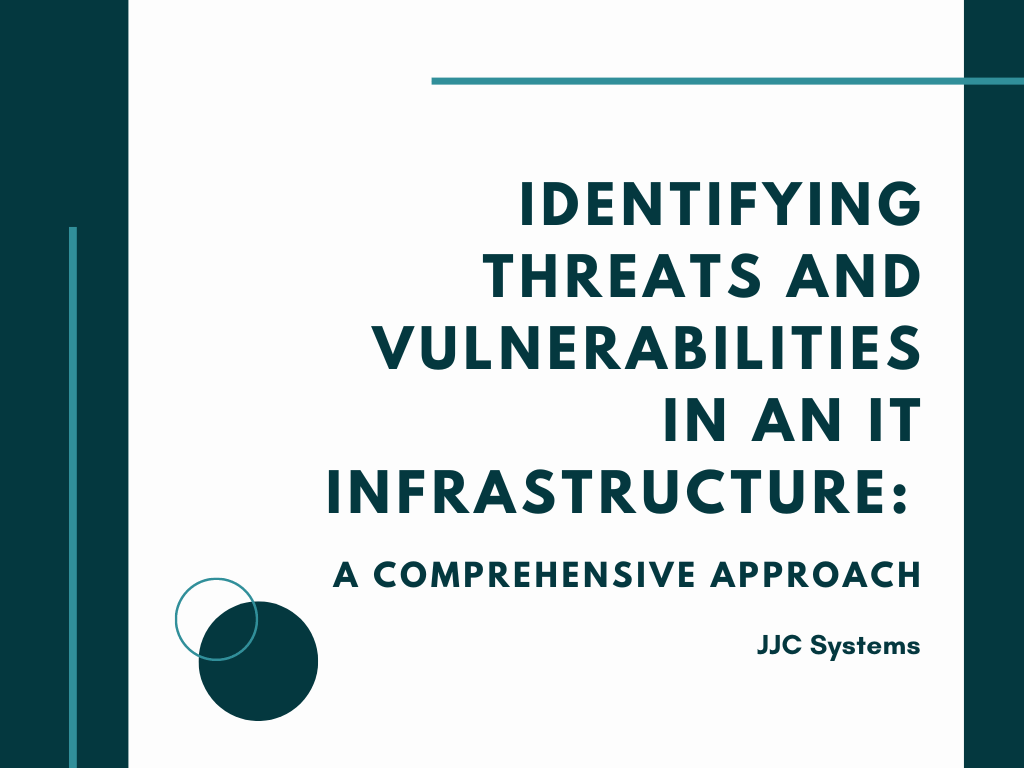Email inquiries to info@jjcsystems.com
Call Now
Support: +1 (888) 329-0625 Press 1
Inquires: +1 (888) 329-0625 Press 2
Email Us
Support: support@jjcsystems.com
Inquiries: info@jjcsystems.com
Referral Program
We greatly value personal recommendations and trust in our clients’ judgment. If you know someone in need of expert tech assistance, we’d love to hear from you! Your referrals mean the world to us.
- Home
- Identifying Threats and Vulnerabilities in an IT Infrastructure: A Comprehensive Approach
Identifying Threats and Vulnerabilities in an IT Infrastructure: A Comprehensive Approach

August 20, 2024 - Technical Procedures
Introduction
In today’s interconnected world, organizations heavily rely on IT infrastructures to manage their operations efficiently. However, with the increasing complexity and sophistication of cyber threats, it has become essential for businesses to proactively identify and mitigate vulnerabilities within their IT systems. This technical blog aims to provide an overview of the process involved in threats detection and cyber vulnerabilities in an IT infrastructure, along with some best practices and tools.
1. Understanding Threats and Vulnerabilities
Before diving into the identification process, it’s crucial to understand the concepts of threats and vulnerabilities:
Threats: These are potential events or incidents that can exploit vulnerabilities and cause harm to an IT infrastructure. Threats can include various types of attacks, such as malware infections, unauthorized access attempts, social engineering, or data breaches.
Vulnerabilities: These are weaknesses or flaws in an IT infrastructure that can be exploited by threats. Vulnerabilities can exist in hardware, software, network configurations, human processes, or even physical security. Common vulnerabilities include outdated software, misconfigurations, weak passwords, and lack of security patches.
2. Establishing a Framework for Identification
To effectively identify threats and vulnerabilities, organizations should follow a systematic framework that covers the entire IT infrastructure. Here are the key steps involved:
Asset Inventory: Begin by creating a comprehensive inventory of all assets within the IT infrastructure, including hardware, software, applications, databases, and network devices. This inventory forms the foundation for identifying potential vulnerabilities and threats.
Risk Assessment: Perform a risk assessment to prioritize assets based on their criticality and potential impact on the organization if compromised. This step helps allocate resources efficiently and focus on the most significant risks.
Threat Intelligence: Stay up-to-date with the latest threat landscape by monitoring relevant sources, such as cybersecurity blogs, industry reports, and threat intelligence feeds. This information provides insights into emerging threats and helps identify potential risks to the IT infrastructure.
Vulnerability Scanning: Utilize vulnerability scanning tools to identify weaknesses and vulnerabilities across the IT infrastructure. These tools automate the process of scanning for known vulnerabilities, misconfigurations, and security flaws in systems, applications, and networks.
Penetration Testing: Conduct periodic penetration tests to simulate real-world attacks and assess the effectiveness of security measures. Penetration testers, either in-house or external experts, attempt to exploit vulnerabilities to gain unauthorized access, allowing organizations to identify weaknesses and implement appropriate countermeasures.
Security Audits: Perform regular security audits to review security controls, policies, and procedures. Audits help identify gaps in security implementation, evaluate compliance with industry standards, and ensure that security measures align with the organization’s objectives.
3. Best Practices for Threats Identification
To enhance the identification process, organizations should incorporate the following best practices:
Patch Management: Establish a robust patch management process to ensure that all systems and software are up to date with the latest security patches. Regularly check for vendor updates and apply patches promptly to address known vulnerabilities.
Security Awareness Training: Conduct regular training sessions to educate employees about potential threats and their role in maintaining a secure IT infrastructure. Awareness about phishing attacks, social engineering, and safe computing practices can significantly reduce the risk of successful attacks.
Network Segmentation: Implement network segmentation to divide the IT infrastructure into smaller, isolated segments. This practice limits the impact of a breach, preventing attackers from gaining access to critical systems and sensitive data.
Regular Backups: Maintain regular backups of critical data to mitigate the impact of ransomware attacks, hardware failures, or data corruption. Test the restoration process periodically to ensure the integrity and availability of backups.
Incident Response Planning: Develop an incident response plan to effectively respond to security incidents. Define roles and responsibilities, establish communication channels, and outline the steps to be taken in case of a breach. Regularly review and update the plan to reflect changes in the threat landscape.
4. Tools for Threats Identification
Several tools and technologies can aid in identifying threats and vulnerabilities. Here are some commonly used ones:
Vulnerability Scanners: Tools like Nessus, OpenVAS, and Qualys can scan IT infrastructures for known vulnerabilities and misconfigurations.
Network Monitoring Tools: Solutions like Wireshark, Nagios, and SolarWinds Network Performance Monitor help monitor network traffic, detect anomalies, and identify potential threats.
Security Information and Event Management (SIEM): SIEM tools, such as Splunk, LogRhythm, and ArcSight, collect and analyze security logs from various sources to identify and respond to security incidents.
Threat Intelligence Platforms: Platforms like ThreatConnect, Recorded Future, and Anomali gather and analyze threat intelligence data, enabling organizations to stay informed about emerging threats.
Conclusion
Threats detection and vulnerabilities is a crucial step in maintaining a secure IT infrastructure. By following a comprehensive framework, incorporating best practices, and utilizing appropriate tools, organizations can proactively identify weaknesses, prioritize risks, and take necessary measures to protect their assets. Regular assessments, continuous monitoring, and an adaptive security strategy are key to staying ahead of evolving cyber threats and safeguarding valuable information and resources.
